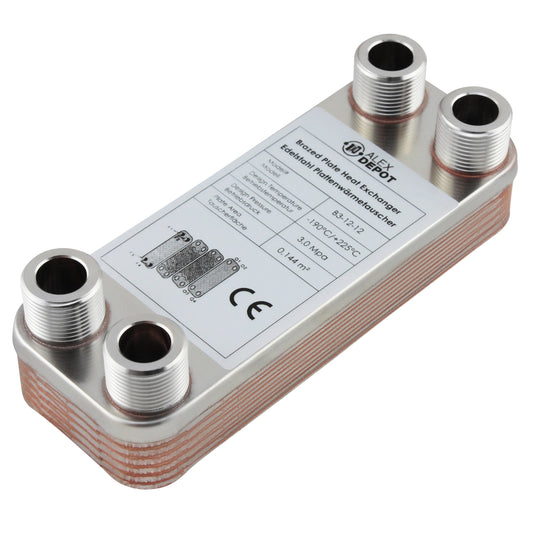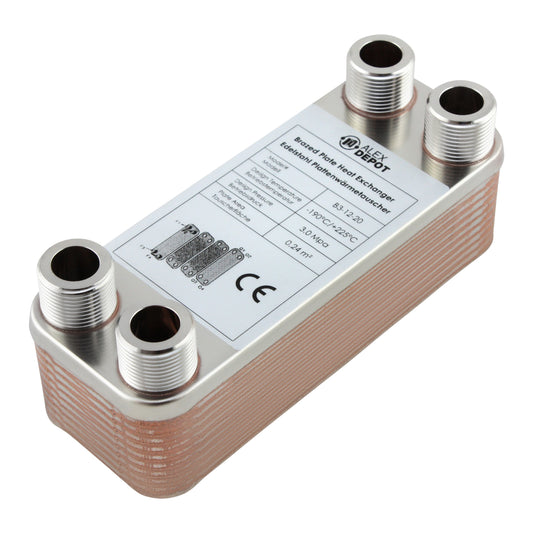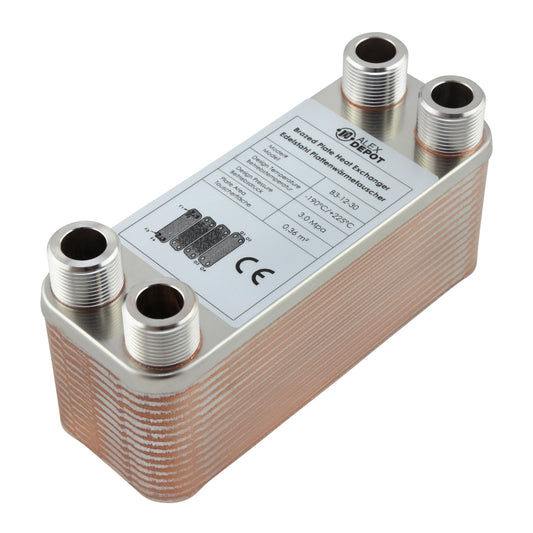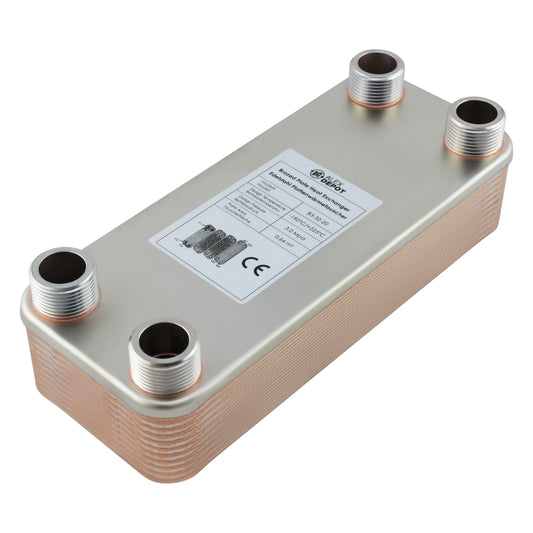Stainless Steel Plate Heat Exchanger
B3-12 Models
B3-23 Models
B3-32 Models
All Plate Heat Exchangers - Model Comparison
 B3-12-12 B3-12-1244,00€
In stock
|
 B3-12-20 B3-12-2059,00€
In stock
|
 B3-12-30 B3-12-3069,00€
In stock
|
 B3-12-40 B3-12-4089,00€
In stock
|
 B3-12-50 B3-12-5099,00€
In stock
|
 B3-12-60 B3-12-60109,00€
In stock
|
 B3-23-20 B3-23-2099,00€
In stock
|
 B3-23-30 B3-23-30129,00€
In stock
|
 B3-23-40 B3-23-40159,00€
Out of stock
|
 B3-23-50 B3-23-50189,00€
In stock
|
 B3-32-20 B3-32-20159,00€
Out of stock
|
 B3-32-30 B3-32-30199,00€
Out of stock
|
 B3-32-40 B3-32-40249,00€
In stock
|
 B3-32-50 B3-32-50269,00€
In stock
|
|
|---|---|---|---|---|---|---|---|---|---|---|---|---|---|---|
| layers Number of Plates | 12 | 20 | 30 | 40 | 50 | 60 | 20 | 30 | 40 | 50 | 20 | 30 | 40 | 50 |
| max. Power | 25 kW | 45 kW | 65 kW | 80 kW | 90 kW | 130 kW | 90 kW | 135 kW | 180 kW | 225 kW | 115 kW | 175 kW | 230 kW | 285 kW |
| view_in_ar Volume | 0,22 L | 0,36 L | 0,54 L | 0,72 L | 0,90 L | 1,08 L | 0,80 L | 1,20 L | 1,60 L | 2,00 L | 1,00 L | 1,50 L | 2,00 L | 2,50 L |
| Heat Exchange Area | 0,114 m² | 0,24 m² | 0,36 m² | 0,48 m² | 0,60 m² | 0,80 m² | 0,46 m² | 0,69 m² | 0,92 m² | 1,15 m² | 0,64 m² | 0,96 m² | 1,28 m² | 1,60 m² |
| Flow rate | max. 4 m³/h | max. 4 m³/h | max. 4 m³/h | max. 4 m³/h | max. 4 m³/h | max. 4 m³/h | max. 4 m³/h | max. 4 m³/h | max. 4 m³/h | max. 4 m³/h | max. 12 m³/h | max. 12 m³/h | max. 12 m³/h | max. 12 m³/h |
| weight Weight | 0,80 kg | 1,11 kg | 1,50 kg | 1,85 kg | 2,23 kg | 2,61 kg | 2,57 kg | 3,41 kg | 4,27 kg | 5,10 kg | 3,86 kg | 4,97 kg | 6,20 kg | 7,50 kg |
|
straighten
Size
(Length x Width x Height) |
L:191mm W:073mm H:034mm | L:191mm W:073mm H:052mm | L:191mm W:073mm H:067mm | L:191mm W:073mm H:097mm | L:191mm W:073mm H:112mm | L:191mm W:073mm H:127mm | L:315mm W:073mm H:052mm | L:315mm W:073mm H:074mm | L:315mm W:073mm H:096mm | L:315mm W:073mm H:119mm | L:286mm W:116mm H:058mm | L:286mm W:116mm H:082mm | L:286mm W:116mm H:103mm | L:286mm W:116mm H:135mm |
|
conversion_path
Connection
|
2x ½ & 2x ¾ or 4x ¾ inches |
2x ½ & 2x ¾ or 4x ¾ inches |
2x ½ & 2x ¾ or 4x ¾ inches |
2x ½ & 2x ¾ or 4x ¾ inches |
2x ½ & 2x ¾ or 4x ¾ inches |
2x ½ & 2x ¾ or 4x ¾ inches |
4x 3/4 inches | 4x 3/4 inches | 4x 3/4 inches | 4x 3/4 inches | 4x 1 inch | 4x 1 inch | 4x 1 inch | 4x 1 inch |
|
split_scene_left
Collection
|
B3-12 Collection | B3-12 Collection | B3-12 Collection | B3-12 Collection | B3-12 Collection | B3-12 Collection | B3-23 Collection | B3-23 Collection | B3-23 Collection | B3-23 Collection | B3-32 Collection | B3-32 Collection | B3-32 Collection | B3-32 Collection |















